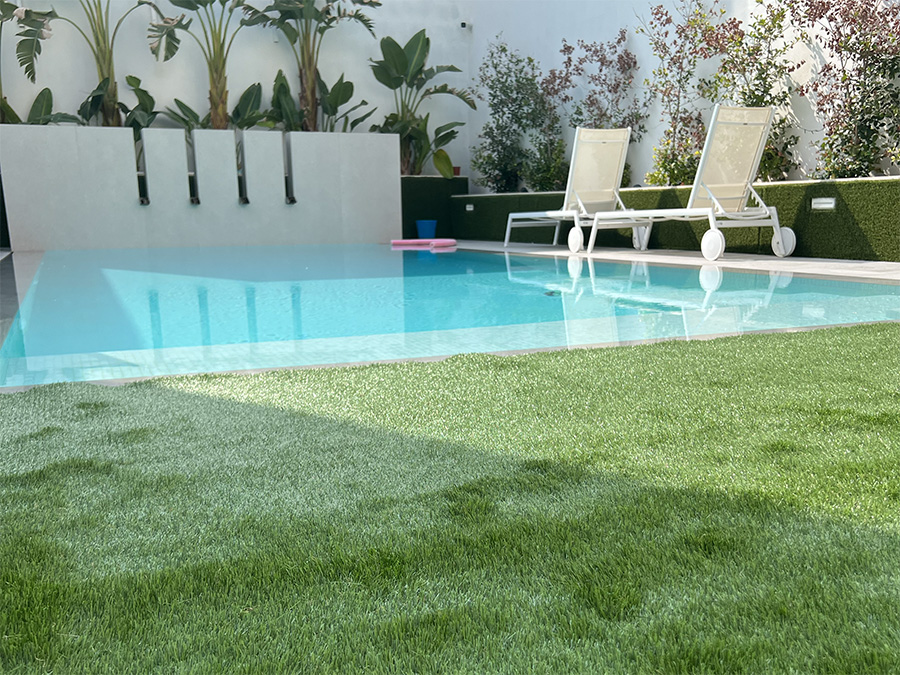
Environmental Certification for Artificial Turf: How to Choose a Green and Safe Artificial Turf Supplier?
With the increasing awareness of environmental protection, more and more consumers are not only focusing on the aesthetics and practicality of artificial turf but also paying special attention to its environmental performance. Environmental certification for artificial turf has become an important standard for measuring its green and safety credentials. So, how can you choose a supplier that meets environmental standards and provides green, safe artificial turf? This article will provide a detailed analysis for you.
1. The Environmental Importance of Artificial Turf: Why Does It Matter?
The environmental performance of artificial turf is not only related to environmental protection but also directly affects the health and safety of users. Traditional artificial turf may contain harmful chemicals such as lead and cadmium, which can pose health risks with long-term exposure. Additionally, substandard artificial turf may generate significant pollutants during production, negatively impacting the environment.
Therefore, choosing an artificial turf supplier with environmental certification is not only a responsibility to the environment but also a safeguard for your own health.
2. Environmental Certification for Artificial Turf: What Are the Standards?
When selecting an artificial turf supplier, understanding relevant environmental certification standards is crucial. Below are some internationally recognized environmental certifications:
2.1. ISO 14001 Environmental Management System Certification
- ISO 14001 is an environmental management system standard developed by the International Organization for Standardization (ISO). Companies with this certification demonstrate that they have implemented effective environmental management measures during production, reducing negative environmental impacts.
2.2 OEKO-TEX Standard 100 Certification
- OEKO-TEX Standard 100 is a globally authoritative environmental certification for textiles. Artificial turf with this certification indicates that its materials are free of harmful substances and safe for human health.
2.3. REACH Regulation Compliance
- REACH is a European Union regulation on the registration, evaluation, authorization, and restriction of chemicals. Artificial turf compliant with REACH regulations has undergone strict chemical testing and is free of harmful substances.
2.4. Green Label Plus Certification
- Green Label Plus is an environmental certification launched by the Carpet and Rug Institute (CRI) in the United States, specifically for carpets and flooring materials. Artificial turf with this certification demonstrates low volatile organic compound (VOC) emissions and is harmless to indoor air quality.
2.5. Cradle to Cradle Certification
- Cradle to Cradle (C2C) is a comprehensive product sustainability certification covering material health, material reuse, renewable energy use, water resource management, and social equity. Artificial turf with C2C certification meets environmental standards throughout its lifecycle.
3. How to Choose a Green and Safe Artificial Turf Supplier?
3.1. Check Environmental Certifications
- When selecting an artificial turf supplier, the first step is to check whether they possess the aforementioned environmental certifications. These certifications are strong evidence of the supplier's commitment to environmental protection, ensuring their products meet international environmental standards.
3.2. Understand Material Sources
- The environmental performance of artificial turf is closely related to its raw materials. High-quality artificial turf typically uses eco-friendly materials such as recyclable polyethylene (PE) or polypropylene (PP). When choosing a supplier, inquire about their material sources to ensure they are free of harmful substances.
3.3. Examine Production Processes
- Environmental certifications not only focus on the product itself but also on the production process. When selecting a supplier, learn whether their production processes employ energy-saving and emission-reducing technologies and whether they minimize wastewater, gas, and waste emissions.
3.4. Review Customer Feedback
- Customer feedback is an important way to assess a supplier's reputation. Conduct online searches, check social media, or visit industry forums to see what other users say about the supplier, gaining insights into their product quality and environmental performance.
3.5. Request Sample Testing
- Before finalizing a supplier, request samples and have them tested by a third-party organization for environmental performance. Ensure the product is free of harmful substances and complies with environmental standards.
4.1. Health and Safety
- Eco-friendly artificial turf contains no harmful substances, making it safe for human health, especially for children, pets, and sensitive individuals.
4.2. Environmentally Friendly
- Eco-friendly artificial turf reduces environmental pollution during production and use, aligning with sustainable development principles.
4.3. Long-Term Cost-Effectiveness
- Although the initial investment in eco-friendly artificial turf may be higher, its durability and low maintenance costs make it more economical in the long run.
4.4. Enhancing Brand Image
- For commercial users, choosing eco-friendly artificial turf is not only a responsibility to the environment but also an important way to enhance brand image.
5. Conclusion
Choosing a green and safe artificial turf supplier is not only a responsibility to the environment but also a safeguard for your own health. By understanding environmental certification standards, evaluating supplier qualifications, reviewing customer feedback, and conducting sample testing, you can find an artificial turf supplier that meets environmental requirements, creating a healthy, safe, and eco-friendly outdoor space.
In the future, as environmental technologies continue to advance, the environmental performance of artificial turf will further improve. Choosing eco-friendly artificial turf not only meets current needs but also contributes to sustainable development. Let’s take action together, choose green and safe artificial turf, and contribute to the global environmental cause!
![synthetic turf suppliers]()

















